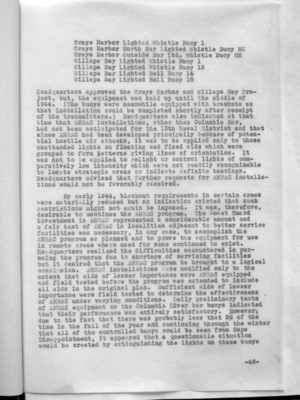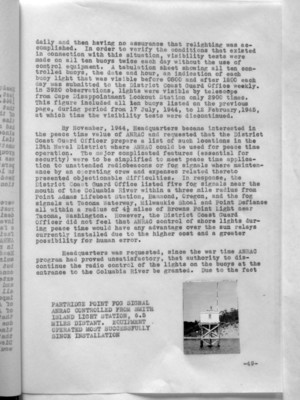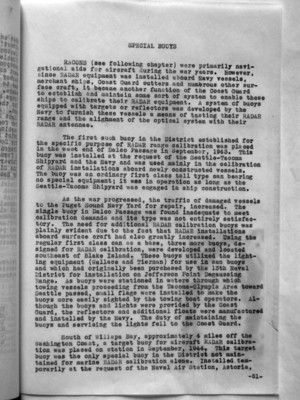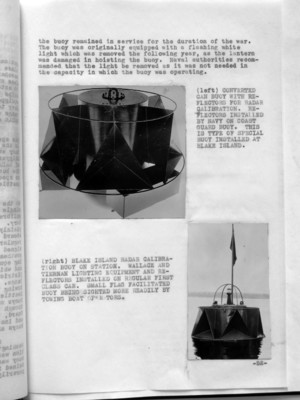Pages That Mention COAST GUARD
Coast Guard District narrative histories 1945
61
be blacked out by the unit having charge of that area. Commanding Officers were instructed to exercise their best judgement in the assignment of trucks, tenders, or small boats and these assignments were determined in advance.
Commanding Officers were further directed to familiarize themselves with the aids in their area, securing keys necessary for entrance to equipment and to properly instruct personnel under their command, in order that the blackout could be carried out smoothly and expeditiously. Sound buoys were silenced by securely lashing bell clappers or air intakes and whistles were wrapped with canvas and securely lashed. The District Coast Guard Office was to be notified by dispatch when the blackout had been effected or aids had been relighted, in accordance with District orders.
In October, 1941, a conference was held at Tongue Point Depot, Astoria, Oregon, to instruct personnel from that area in the operations required of the various types of aids to navigation to effect the Blackout Plan. A blackout drill of all units under command of the Astoria Base was held on October 22, 1941. Each aid was visited and examined by the personnel assigned thereto to ascertain type of equipment, the correct way to make the aid inoperative and the tools and materials required. During the practice, only an examination was made and the operation of the aids was not stopped. This was the only test of its kind in the 13th Naval District prior to the outbreak of the war.
On 9 December, 1941, a blackout was effected in the entire District on instructions from the District Commandant. Three officers, together with a small staff of enlisted personnel, issued instructions to the various Commands from the Aids to Navigation Office. Orders for the blackout were received at 1400 and, by 2200, the blackout was completely effected. Tremendous obstacles were encountered, there having been no previous test of the Plan as set by the Board in September. Bridges throughout the District were blacked out, although no plan had incorporated such procedure and railroad officials as well as highway superintendents offered little cooperation. No word was received from the blacked areas as to the time their aids were extinguished nor was word received that they had been relighted following the blackout. This was due to the inability of telephone and radio facilities to handle such heavy traffic. No report was required concerning the results of the operation and a general blackout, other than tests in various areas, was every made in the District.
-41-
68
Grays Harbor Lighted Whistle Buoy 1 Grays Harbor North Bar Lighted Whistle Buoy NC Grays Harbor Outside Bar Ltd. Whistle Buoy GH Willapa Bay Lighted Whistle Buoy 1 WIllapa Bay Lighted Whistle Buoy 12 Willapa Bay Lighted Bell Buoy 14 Willapa Bay Lighted Bell Buoy 18
Headquarters approved the Grays Harbor and Willapa Bay Project, but, the equipment was held up until the middle of 1944. (The buoys were meanwhile equipped with brackets so that installation could be completed shortly after receipt of the transmitters.) Headquarters also indicated at that time that ANRAC installations, other than Columbia Bar, had not been anticipated for the 13th Naval District and that since ANRAC had been developed principally because of potential hostile air attacks, it was to be applied only to those unattended lights on floating and fixed aids which were grouped to form patterns giving lines of orientation. It was not to be applied to relight or control lights of comparatively low intensity which were not readily recognizable to locate strategic areas or indicate definite bearings. Headquarters advised that further requests for ANRAC installations would not be favorably received.
By early 1944, blackout requirements in certain areas were materially reduced but no indication existed that such restrictions might not again be imposed. It was, therefore, desirable to continue the ANRAC program. The Coast Guard investment in ANRAC represented a considerable amount and a fair test of ANRAC in localities adjacent to better service facilities was necessary, in any case, to accomplish the ANRAC program as planned and to prove the equipment for use in remote areas where need for same continued to exist. Headquarters realized the difficulties encountered in pursuing the program due to shortage of servicing facilities but it desired that the ANRAC program be brought to a logical conclusion. ANRAC installations were modified only to the extent that aids of lesser importance were ANRAC equipped and field tested before the program was extended to include all aids in the original plan. Sufficient aids of lesser importance were field tested to determine the effectiveness of ANRAC under varying conditions. Daily preliminary tests of ANRAC equipment on the Columbia River bar buoys indicated that their performance was entirely satisfactory. However, due to the fact that there was probably less that 5% of the time in the fall of the year and continuing through the winter that all of the controlled buoys could be seen from Cape Disappointment, it appeared that a questionable situation would be created by extinguishing the lights on these buoys
-48-
69
daily and then having no assurance that relighting was accomplished. In order to verify the conditions that existed in connection with this situation, visibility tests were made on all ten buoys twice each day without the use of control equipment. A tabulation sheet showing all ten controlled buoys, the date and hour, an indication of each buoy light that was visible before 0800 and after 1200 each day was submitted to the District Coast Guard Office weekly. In 3920 observations, lights were visible by telescope from Cape Disappointment Lookout Station only 2900 times. This figure included all ten buoys listed on the previous page, during period from 17 July, 1944, to 12 February, 1945, at which time the visibility tests were discontinued.
By November, 1944, Headquarters became interested in the peace time value of ANRAC and requested that the District Coast Guard Officer prepare a list of such locations in the 13th Naval District where ANRAC could be used for peace time operation. The major complicated features (essential for security) were to be simplified to meet peace time application to unattended radiobeacons or fog signals where maintenance by an operating crew and expenses related thereto presented objectionable difficulties. In response, the District Coast Guard Office listed five fog signals near the mouth of the Columbia River within a three mile radius from Point Adams Lifeboat Station, Hammond, Oregon, and the fog signals at Tacoma Waterway, Milwaukie Shoal and Point Defiance all within a radius of 4 1/2 miles of Browns Point Light near Tacoma, Washington. However, the District Coast Guard Officer did not feel that ANRAC control of shore lights during peace time would have any advantage over the sun relays currently installed due to the higher cost and a greater possibility for human error.
Headquarters was requested, since the war time ANRAC program had proved unsatisfactory, that authority to discontinue the radio control of the lights on the buoys at the entrance to the Columbia River be granted. Due to the fact
(image)
PARTRIDGE POINT FOG SIGNAL ANRAC CONTROLLED FROM SMITH ISLAND LIGHT STATION, 6.5 MILES DISTANT. EQUIPMENT OPERATED MOST SUCCESSFULLY SINCE INSTALLATION
-49-
71
SPECIAL BUOYS
RACONS (see following chapter) were primarily navigational aids for aircraft during the war years. However, since RADAR equipment was installed aboard Navy vessels, merchant ships, Coast Guard cutters and numerous other surface craft, it became another function of the Coast Guard to establish and maintain some sort of system to enable these ships to calibrate their RADAR equipment. A system of buoys equipped with targets or reflectors was developed by the Navy to furnish these vessels a means of testing their RADAR range and the alignment of the optical system with their RADAR antennae.
The first such buoy in the District established for the specific purpose of RADAR range calibration was placed in the west end of Dalco Passage in September, 1943. This buoy was installed at the request of the Seattle-Tacoma Shipyard and the Navy and was used mainly in the calibration of RADAR installations aboard newly constructed vessels. The buoy was an ordinary first class tall type can bearing no special equipment; it was in operation as long as the Seattle-Tacoma Shipyard was engaged in ship construction.
As the war progressed, the traffic of damaged vessels to the Puget Sound Navy Yard for repair, increased. The single buoy in Dalco Passage was found inadequate to meet calibration demands and its type was not entirely satisfactory. The need for additional RADAR calibration buoys was plainly evident due to the fact that RADAR installations aboard surface craft had also greatly increased. Using the regular first class can as a base, three more buoys, designed for RADAR calibration, were developed and located southeast of Blake Island. These buoys utilized the lighting equipment (Wallace and Tiernan) for use in can buoys and which had originally been purchased by the 13th Naval District for installation on Jefferson Point Degaussing Range. As buoys were stationed in waters through which towing vessels proceeding form the Tacoma-Olympia Area toward Seattle passed, small flags were installed to make the buoys more easily sighted by the towing boat operators. Although the buoys and lights were provided by the Coast Guard, the reflectors and additional floats were manufactured and installed by the Navy. The duty for maintaining the buoys and servicing the lights fall to the Coast Guard.
South of Willapa Bay, approximately 4 miles off the Washington Coast, a target buoy for aircraft RADAR calibration was placed on station in September, 1944. This target buoy was the only special buoy in the District not maintained for marine RADAR calibration alone. Installed temporarily at the request of the Naval Air Station, Astoria,
-51-
72
the buoy remained in service for the duration of the war. The buoy was originally equipped with a flashing white light which was removed the following year, as the lantern was damaged in hoisting the buoy. Naval authorities recommended that the light be removed as it was not needed in the capacity in which the buoy was operating.
(image)
(left) CONVERTED CAN BUOY WITH RE FLECTORS FOR RADAR CALIBRATION. RE FLECTORS INSTALLED BY NAVY ON COAST GUARD BUOY. THIS IS TYPE OF SPECIAL BUOY INSTALLED AT BLAKE ISLAND.
(image)
(right) BLAKE ISLAND RADAR CALIBRA TION BUOY ON STATION. WALLACE AND TIERNAN LIGHTING EQUIPMENT AND RE FLECTORS INSTALLED ON REGULAR FIRST CLASS CAN. SMALL FLAG FACILITATED BUOY BEING SIGHTED MORE READILY BY TOWING BOAT OPERATORS.
-52-




